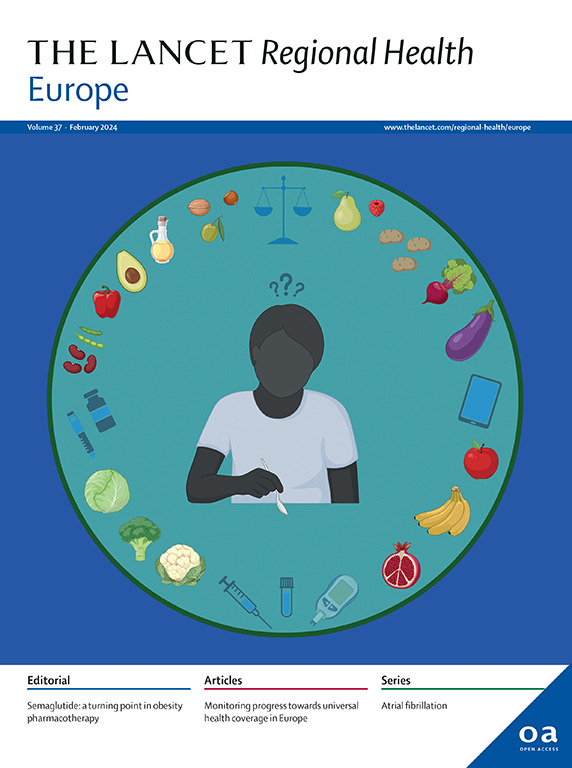Socioeconomic inequalities in diagnostics, care and survival outcomes for hepatocellular carcinoma in Sweden: a nationwide cohort study
IF 13.6
Q1 HEALTH CARE SCIENCES & SERVICES
引用次数: 0
Abstract
Background
Hepatocellular carcinoma (HCC) is a leading cause of cancer-related mortality worldwide. This study evaluates how strongly socioeconomic factors associate with diagnostics, treatment, and survival among patients with HCC in Sweden.
Methods
All adult patients registered with a diagnosis of HCC in the Swedish quality register for liver cancer between 2011 and 2021 were included. Household income was classified as low (first quartile; poorest), medium (second or third quartile), or high (in fourth quartile; wealthiest) based on the overall distribution of household income across all household in Sweden. Outcomes included likelihood of diagnosis under surveillance, early-stage diagnosis (Barcelona Clinic Liver Cancer [BCLC] staging 0-A), and receipt of curative treatment (ablation, resection or liver transplantation), as well as mortality risk.
Findings
Among 5490 patients, a significant association was found between low household income and decreased likelihood of diagnosis while under surveillance (adjusted odds ratio [aOR] 0·63; 95% confidence interval [CI]: 0·50–0·80), early-stage diagnosis (aOR 0·58; 95% CI: 0·51–0·67), and curative treatment receipt (aOR 0·65; 95% CI: 0·50–0·85). After adjustments for all variables in the BCLC, other sociodemographic variables, comorbidities, and cirrhosis status, patients with low household income had an adjusted hazard ratio for mortality of 1·29 (95% CI: 1·15–1·45) compared to patients with high household income.
Interpretation
Socioeconomic disparities associate markedly with more advanced stage at HCC diagnosis, less curative treatment, and poorer survival in Sweden. Addressing these disparities through targeted public health interventions may improve HCC care and outcomes in socioeconomically disadvantaged populations.
Funding
The Swedish Cancer Society—Cancerfonden.
背景肝细胞癌(HCC)是全球癌症相关死亡的主要原因。本研究评估了社会经济因素与瑞典 HCC 患者的诊断、治疗和存活率之间的密切关系。方法纳入 2011 年至 2021 年期间在瑞典肝癌质量登记册中登记并诊断为 HCC 的所有成年患者。根据瑞典所有家庭收入的总体分布情况,将家庭收入分为低(第一四分位数;最贫穷)、中(第二或第三四分位数)或高(第四四分位数;最富有)。结果包括在监测下确诊的可能性、早期诊断(巴塞罗那临床肝癌 [BCLC] 分期 0-A)、接受治愈性治疗(消融、切除或肝移植)以及死亡风险。研究结果在5490名患者中发现,家庭收入低与监测期间确诊的可能性降低(调整赔率[aOR]0-63;95%置信区间[CI]:0-50-0-80)、早期诊断(aOR 0-58;95% CI:0-51-0-67)和接受治愈性治疗(aOR 0-65;95% CI:0-50-0-85)之间存在显著关联。在对 BCLC 中的所有变量、其他社会人口学变量、合并症和肝硬化状态进行调整后,与高家庭收入患者相比,低家庭收入患者的调整后死亡率危险比为 1-29 (95% CI: 1-15-1-45)。通过有针对性的公共卫生干预措施来解决这些差异,可以改善社会经济弱势人群的HCC护理和治疗效果。
本文章由计算机程序翻译,如有差异,请以英文原文为准。
求助全文
约1分钟内获得全文
求助全文
来源期刊

Lancet Regional Health-Europe
Multiple-
CiteScore
19.90
自引率
1.40%
发文量
260
审稿时长
9 weeks
期刊介绍:
The Lancet Regional Health – Europe, a gold open access journal, is part of The Lancet's global effort to promote healthcare quality and accessibility worldwide. It focuses on advancing clinical practice and health policy in the European region to enhance health outcomes. The journal publishes high-quality original research advocating changes in clinical practice and health policy. It also includes reviews, commentaries, and opinion pieces on regional health topics, such as infection and disease prevention, healthy aging, and reducing health disparities.
 求助内容:
求助内容: 应助结果提醒方式:
应助结果提醒方式:


